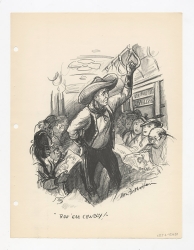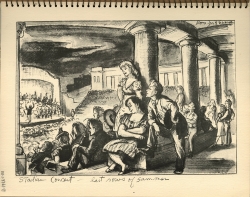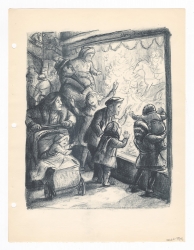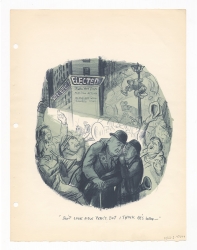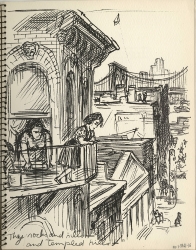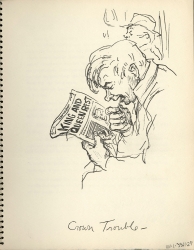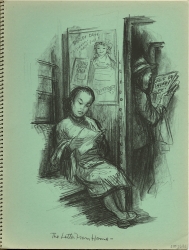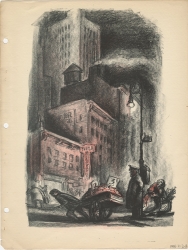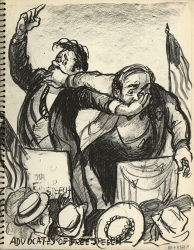Introduction
The tagline for Don Freeman’s visual journal Newsstand was “Signs of the Times in Lithographs.” This periodical documented daily life in New York City during and after the Great Depression and during the Second World War. In later volumes, Freeman illustrated life in post-war Los Angeles.
The lithographs of Newsstand offered readers a man-on-the-street perspective of some of the most tumultuous years in American life. Throughout its decade-long run of quarterly volumes, beginning in 1936, Newsstand showcased all walks of urban life. The periodical would continue on an irregular basis, with years passing between issues, until the final volume was published in 1968.
These images are selections from the Art Collection of the Georgetown University Booth Family Center for Special Collections.
Artist Biography
“I saw. I wanted others to see.” - Don Freeman
The graphic artist Don Freeman (1908 - 1978) is perhaps best known for his children’s books, including Corduroy (1968). He created art with the Works Progress Administration’s Federal Art Project during the Great Depression. During the Second World War, he served in the U.S. Army. His works have been exhibited at the Whitney Museum of Art in New York, the Art Institute of Chicago, the National Gallery of Art in Washington, D.C., and the American Institute of Graphic Arts in New York. Today, Freeman’s prints are part of the permanent collections of museums and libraries, including the Metropolitan Museum of Art in New York, the Library of Congress in Washington, D.C., and the Smithsonian.
Further Reading
Freeman, Roy. “Don Freeman: Artist, Illustrator, Author, Life-Lover.” The Website of Don Freeman. https://donfreeman.info/enter.
McCulloch, Edith. The Prints of Don Freeman: A Catalogue Raisonné. Charlottesville: University Press of Virginia. 1988.
Additional digitized images from Newsstand are available on the websites of the Museum of the City of New York, the Library of Congress, and the Smithsonian American Art Museum.
Together
Freeman often sketched the crowds of New York City. His lithographs for Newsstand documented the bustle of a city during the Great Depression. Though Freeman frequently drew crowded city scenes, virtually each face was provided with expressive detail.
Ride ’Em, Cowboy
Lithograph on paper
1936
1111.1.4724.10
Films and stage musicals about the American West were hugely popular during the 1930s. In 1936, when Freeman published this lithograph, The Big Show starring Gene Autry had just been released in theaters.
Stadium Concert: Last Rows of Summer
Lithograph on paper
1939
1111.1.3361.19
New Yorkers celebrate the end of summer at a concert. Some audience members look forlorn, others appear glad for the coming autumn.
Untitled [Toy shop]
Lithograph on paper
1936
1111.1.4724.3
Families out for a walk are waylaid by the window display of a toyshop. Children of all ages are riveted by the rocking horse in the window. Even a baby in a stroller is enticed by the toy.
"Don’t Look Now, Percy, but I Think He’s Won"
Lithograph on paper
1936
1111.1.4724.4
In the foreground, two well-dressed men are surprised by the results of the 1936 presidential election. They are surrounded by revelers who are raucously celebrating the re-election of Franklin D. Roosevelt.
Apart
Newsstand illustrated city life at it most frenetic and at its most placid. Freeman’s work sketching dramas both on-stage and backstage helped him frame these scenes of rest and reflection.
Thy Rocks and Rills and Templed Hills
Lithograph on paper
1939
1111.1.3361.16
From a balcony, a woman and girl gaze upon the quiet street below. In the distance, the Brooklyn Bridge spans the East River. The title of the work references the American patriotic song “My Country ’Tis of Thee.”
Crown Trouble
Lithograph on paper
1939
1111.1.3361.27
A man reads the newspaper and fusses with his tooth. The caption “crown trouble” refers to the news headline about the monarchs and the man’s apparent toothache.
Madonna of the Fire Escape
Lithograph on paper
1939
1111.1.3361.3
On hot summer nights, people would often sleep on their fire escapes, hoping for relief from the heat. Here, a woman plays with her baby as they try to keep cool.
Letter from Home
Lithograph on colored paper
1937
1997.1.107.2
In the foreground, a Chinese woman reads a letter from friends or relatives; in the background a white man reads a newspaper with the headline “Drive On, Shanghai.” One might infer they are reading the same news, about the 1937 Battle of Shanghai, from different sources.
Snow Men
Lithograph on paper
1937
1995.21.1.3
Two public works men with shovels trudge through snow. One looks towards the other as though in mid-conversation.
City Night
Lithograph on paper
1937
1995.21.2.15
A man pushes a cart of produce on a nearly empty street. The only other people he sees at this hour are a police officer and a woman with her young child.
Untitled (Grocer)
Lithograph on paper
1939
1111.1.3361.4
A grim-looking grocer crosses his arms in front of his cart. It seems no one is buying pineapples today.
Advocates of Free Speech
Lithograph on paper
1939
1111.1.3361.9
Two politicians attempt to speak on their respective soapboxes. Neither can, as their mouths are covered by the other’s hand.
Curated by Maire O'Donnell, University Art Collection Curatorial Intern and Graduate Student in Art and Museum Studies, Spring 2020

